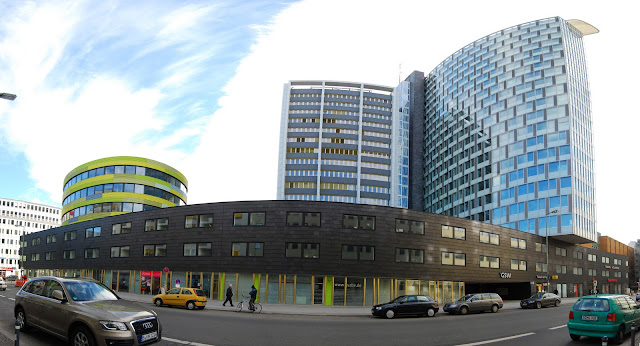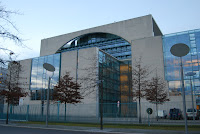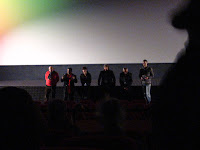Spain is fantastic.
I instantly fell in love with Madrid when we arrived. It was so different from what I have been experiencing in Berlin. In a way, it reminded me of Boston because it is such a historic city yet there are attempts to make it modern. Their way of life is just so wonderful. I wish we could have participated in a siesta fiesta in the middle of the day! And people don't eat dinner until at least 9pm, which I've been doing for the past few years because of architecture anyways. The city has this energy I can't describe; the people are friendly and so very attractive. I'm happy to be returning to Barcelona this coming weekend.
Now on to my travels.
Thursday morning was brutal; we had to wake up before the sun did and take a private bus to the airport at 6am. While we were waiting to board the plane, Tyler met a girl named Tess, and I ended up sitting next to her on the plane as well. She was from the US, lived in Madrid for seven years, and is now in Berlin looking for work. It worked out perfectly because she provided us with all these little insider tips, and she also talked to me about Barcelona.


When we disembarked the airplane, we were at our first site: the airport. We went over to Terminal 4 to check our Richard Roger's terminal, which I happen to love very much. The general shape is a wing that is extruded horizontally, but the use of materials and colors is just wonderful. The roof is covered with bamboo, providing this warm feeling that makes you want to stay in the terminal, and the colors cover the steel structures that are supposed to help direct you (but the terminal is covered with signs everywhere... not thrilled about that). But the terminal is just a great space.


We took the Metro to our hotel (Petit Palace in Puerto del Sol) and found lunch at a random cafe. We met up again as a group to walk around the city. Our first stop was Plaza Mayor, where our professors discussed how the urban design was accomplish, and then we sketched some of the ideas in our sketchbooks. After an hour or so, we walked over to a palace (I think it was the Patrimonio Nacional) and talked a bit before being "dismissed" for the day. A group of us tried finding a park that Tess recommended for seeing the sunset, but, being with groups, people wandered off, time was wasted, and we didn't end up where we wanted to. We headed back to the hotel to take a break before going out to dinner.

I had googled for a tapas restaurant, but the one I looked up didn't exist, so we wandered the streets a bit and ended up at a hookah bar called Color. The food was shit and drinks were weak, but hookah was pretty good. After a few drinks, we decided to find another bar but didn't know where. Let me let you in on a secret; if you're ever bored, walk around Puerto del Sol because you will get a million little cards and ads. One girl convinced us to go to an Irish pub because everyone got free shots and girls got a free cocktail, so we followed her and found a group of our classmates already there! It was a very fun night filled with lots of drinks. In the morning, I realized that I sadly forgot my black hoodie at the bar, but I bought the same one again at H&M next door.


Our first destination on Friday was Escuela Pias, and old church ruin that had been converted into a library (initially proposed as a gym!). The outside wasn't much, but the interior was absolutely beautiful. The architect, José Ignacio Linazasoro, respected the ruins and incorporated it into the new building. There are other spaces that are used by students, but we didn't get to tour that part. We did get to see the roof though, and on the roof is a cafe/bar called Gaudemaus Cafe. I was hoping to go back one of the nights we were in Madrid, but I guess I will just have to return someday.
Next stop was another renovation of an old beer factory that turn into a disco that turned into a cultural center that turned into a library and city archive. Unfortunately, no pictures were allowed, but that doesn't matter because the building was very unimpressive after seeing the Escuela Pias. Seriously nothing special.


After our lunch break, we all walked over to my precedent building, the Prado Museum, extension designed by Rafael Moneo (original by Juan Villaneuva)! Ever since having my epic almost-encounters with celebrities at the LA Cathedral, I've been a big fan of Moneo. Again, this building fits perfectly with its surroundings. Moneo, like Linazasoro, respected the exisiting site. He used similar materials that let you know that it's part of the museum. Most of the extension is underground except for the part where the cloister exists. The cloister was part of the old monastery, but it was taken apart, stone by stone, cleaned up, and reassembled and incorporated into Moneo's extension. Like most awesome museums, photographs were not allowed on the inside, so I did my best to sneak a picture of the entrance area. A group of us walked around the museum to look at the exhibits, but the artwork wasn't my favorite, so I just tagged along and admired the architecture. We walked around the exterior afterwards to see the front of Villaneuva's original design before heading back to the hotel.


I took it easy that night and went out to dinner with a group of guys to a buffet. Madrid is expensive when it comes to food, so I was constantly hungry the entire time. I stuffed myself as much as I could at the buffet and called it a night after that.


Saturday was another packed day. We switched our itinerary a bit, so our first stop was Las Arquerias, which was an old Metro tunnel that was converted into an architectural documentation center. The exhibit currently on display explored alternative habitats. It was a great exhibit, and the renovation of this space was fantastic. You could see every little tectonic detail--it was all very honest in its construction.





By the time we finished, it was already noon. We headed over to the Caixa Forum, an old power station, renovated by Herzog and de Meuron. We were given time to explore and eat lunch, but I skipped lunch to walk around the center. As it was with the de Young Museum, I wasn't too impressed. To me, Herzog and de Meuron are all about materials and facades, and there's no doubt that they're the masters of that. The interior wasn't special though. The only "cool" aspect was the staircase, but when I got to the top, I was hoping to see more natural light than they had. I will give them credit for suspending the first floor plate--a detail I would have missed if our professor hadn't pointed it out. The Caixa Forum is lifted off the ground, but there are no columns supporting it when you're looking at it from the exterior. I thought that was a clever idea.


Our last destination on our itinerary was the Reina Sofia, extension designed by Jean Nouvel. The original building was once a hospital, but eventually it was declared the national museum, and now houses some of the most famous paintings in the world. We discussed the exterior a bit and went to the terraces as well, and then we were free to explore the museum. The place is huge, so we narrowed it down to a few artists we wanted to see. I was thrilled to see that they had Richard Serra! We also found Picasso's Guernica and a lot of Dali's works.



That night, I wanted to go to a tapas restaurant, but other people wanted entrees and meals, so we compromised and found a restaurant that had both. It was about 8pm and we were the only ones in the restaurant. Like I said before, Madrid is expensive when it comes to eating out. People ordered steaks for 18 Euros and it looked so pathetic on the plate when it came out. Fortunately, the people I was with were great; we had a good dinner and funny conversations. After dinner, Jeri, Sarah, Erblin, and I wanted dessert, so we walked to a nearby cafe called Cafe & Te and ended up getting ice cream, churros, some sort of waffle and ice cream dessert... it was a good way to end the night. When we got back to the hotel, I fell asleep attempting to write in my journal (a physical journal, not this blog) but was awoken by others who were trying to get me to go clubbing. Thankfully I passed because the next day, I heard it wasn't that good of a club.


Sunday, we left Madrid with our own private bus and visited the town of Sanchinarro to see the Mirador building by MVRDV. I happened to like the building, at least from the exterior, because it took the usual housing block with a courtyard in the center and flipped it on its side. Sadly, the area around the building was pretty much desolate. There was barely any life around. We went down a couple blocks and found a lot of housing complexes, but again, it was barren. Lots of things to consider when you're an urban designer.



We ended our trip in the old capital of Spain: Toledo. We were given about four hours to explore the city and get lunch and whatever else we wanted to to. I walked around with Sarah, Jeri, Erblin, and Jeff, and for lunch, we stopped by a cafe/bar called Scorpions, and we all got entrees for only 10 Euros each! It was so nice to find a "cheap" restaurant and actually feel full! Toledo was a nice city, but I would never stay more than a day.
Eventually it was time to leave, so we all met up to go to the airport and fly back to Berlin. It's nice to be back.














































